Golf has seen some of the most thrilling and intense rivalries in sports history. These rivalries, from iconic battles at the Masters Tournament to personal feuds that have captured the public’s attention, have defined eras and elevated the game.
This article explores the greatest golf rivalries and goes through epic battles on the green that have left a lasting impact on the sport.
- 1) The Big Three: Arnold Palmer, Jack Nicklaus and Gary Player
- 2) The Duel in the Sun: Jack Nicklaus vs. Tom Watson
- 3) The Collapse of Greg Norman: Greg Norman vs. Nick Faldo
- 4) Modern Titans: Tiger Woods vs. Phil Mickelson
- 5) Rising Stars: Jordan Spieth vs. Justin Rose
- 6) The Ryder Cup: USA vs. Europe
- 7) Women’s Golf Rivalries: Mickey Wright vs. Kathy Whitworth
- 8) Feuds and Fights: Notable Personal Conflicts
- 9) Historical Perspectives: Sam Snead vs. Ben Hogan
- 10) Controversies and Conflicts: Impact on the Game
-
11)
Frequently Asked Questions
- 11.1) What was the greatest rivalry in golf history?
- 11.2) How did the rivalry between Arnold Palmer and Jack Nicklaus shape modern golf?
- 11.3) What are some of the most memorable moments from the Ryder Cup?
- 11.4) How have personal feuds affected players’ performances in major tournaments?
- 11.5) Who are the top female golfers with historic rivalries?
- 12) Final thoughts
The Big Three: Arnold Palmer, Jack Nicklaus and Gary Player
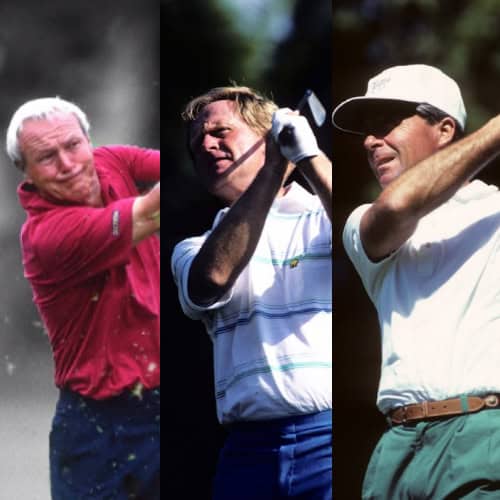
Arnold Palmer, Jack Nicklaus, and Gary Player – known as “The Big Three” – were titans of golf in the 1960s and early 1970s. Their fierce competition and mutual respect elevated the sport to new heights.
During this era (1960s – early 1970s), the trio collectively dominated the Masters Tournament. Palmer, with his charismatic flair, Nicklaus, the methodical “Golden Bear” and Player, the relentless “Black Knight,” were fixtures atop the leaderboard. Between them, they won 13 Masters Tournaments, showcasing their unrivaled skills and competitive spirit. Some key moments in the trio’s rivalry include the following:
- 1960 Masters: Palmer’s dramatic victory with a final-round charge set the stage for his legendary status.
- 1965 Masters: Nicklaus’ record-breaking win by nine strokes, the largest margin of victory at that time.
- 1961 Masters: Player became the first non-American to win, demonstrating global reach and influence.
Impact on the Popularity of Golf
The rivalry among The Big Three did more than fill galleries; it transformed golf’s image. Palmer’s magnetism drew spectators, Nicklaus’ precision brought respect, and Player’s international success expanded the sport’s appeal. They became household names and their battles were must-watch events.
Together, they were ambassadors of the game. Their rivalry, built on respect and admiration, set a standard for sportsmanship and excellence. The Big Three will always be remembered for their wins as well as how they made the sport we love today.
If you have time, you can watch an excellent documentary (26 min. 26 sec.) covering the Big Three’s rivalry:
The Duel in the Sun: Jack Nicklaus vs. Tom Watson
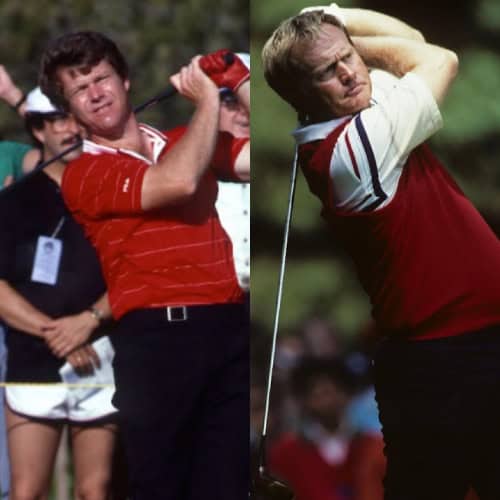
The rivalry between Jack Nicklaus and Tom Watson is legendary. Their competition reached its zenith at the 1977 Open Championship, famously dubbed “The Duel in the Sun.” Their contrasting styles made their matches compelling, as fans witnessed a blend of raw power (Nicklaus) and tactical brilliance (Watson).
In July 1977, the stage was set at Turnberry. The final two rounds became a head-to-head showdown between Nicklaus and Watson, leaving the rest of the field far behind. Under the scorching sun, both golfers played some of the finest golf ever witnessed. Here are two special moments of the open championship:
- Round Three: Watson fired a sensational 65, but Nicklaus matched him shot for shot.
- Final Round: The tension was palpable. Watson edged ahead with birdies, but Nicklaus fought back. On the 18th hole, Watson sealed his victory with a birdie, finishing one shot ahead of Nicklaus.
Their sportsmanship shone through as they embraced after the final putt, symbolizing mutual respect. Nicklaus acknowledged Watson’s role in pushing him to maintain his dominance. Watson, in turn, saw Nicklaus as the benchmark he needed to surpass. This mutual drive led to some of the most thrilling moments in golf history.
For all the details, we invite you to read a dedicated CNN article on the duel in the sun.
The Collapse of Greg Norman: Greg Norman vs. Nick Faldo
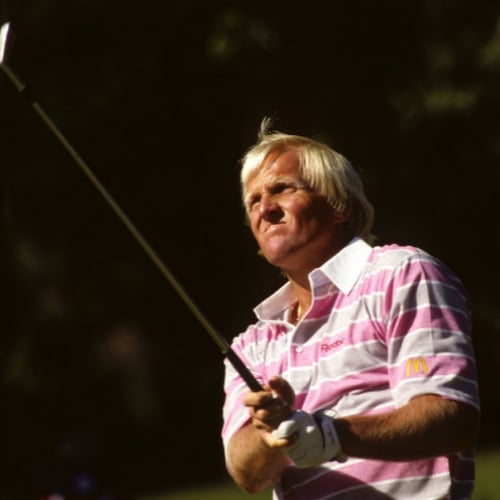
The 1996 Masters Tournament remains etched in golfing history, largely due to the dramatic showdown between Greg Norman and Nick Faldo. This event is remembered for its shocking outcome and the psychological depth of the rivalry.
During the tournament, Greg Norman entered the final round with a six-shot lead over Nick Faldo. Known as “The Great White Shark,” Norman had showcased dominance throughout the tournament. Fans expected him to cruise to victory. However, here’s what happened:
- Front Nine Troubles: Norman’s struggles began early. Bogeys on the 9th and 10th holes started chipping away at his lead. Faldo, playing with steady precision, capitalized on Norman’s mistakes.
- Back Nine Collapse: The 12th hole proved disastrous for Norman with a double bogey. Faldo’s calm demeanor and consistent play saw him inch closer. By the 15th hole, Faldo had overtaken Norman, who couldn’t regain his composure.
As the final holes unfolded, Faldo maintained his focus while Norman’s game unraveled. The emotional scene on the 18th green, with Faldo consoling a devastated Norman, highlighted the human aspect of this intense rivalry.
Examination of Their Head-to-Head Battles
Norman and Faldo’s rivalry was defined by their contrasting styles and frequent head-to-head encounters in major tournaments. Norman’s aggressive play often clashed with Faldo’s meticulous, methodical approach. This dynamic made their battles captivating.
This rivalry, highlighted by the 1996 Masters, illustrates the unpredictable and emotional nature of golf. It’s a reminder that even the greatest players can face moments of vulnerability, and that triumph often comes to those who master both the game and their own minds.
Modern Titans: Tiger Woods vs. Phil Mickelson

The rivalry between Tiger Woods and Phil Mickelson is one of the most captivating in modern golf. Their battles throughout the early 2000s defined an era and brought immense excitement to the sport.
Both Woods and Mickelson were known for their exceptional driving abilities, albeit with different approaches. Woods relied on power and precision, while Mickelson often favored a more aggressive strategy off the tee.
Tiger Woods burst onto the scene in the late 1990s, quickly establishing himself as a dominant force. With his unparalleled athleticism and relentless drive, Woods set new standards for excellence. Phil Mickelson, known for his creative shot-making and risk-taking, provided a perfect foil. Their contrasting styles and personalities made every encounter a must-watch.
Significant Tournaments and Matchups
- 2001 Masters Tournament: Woods completed the “Tiger Slam,” holding all four major titles simultaneously. Mickelson, always the bridesmaid, finished third, showcasing the gap between them at the time.
- 2004 Masters Tournament: Mickelson finally broke through, capturing his first major. His thrilling final-round birdie on the 18th hole cemented his place among golf’s elite. This victory marked a significant moment in their rivalry.
- 2005 Ford Championship at Doral: In a head-to-head showdown, Woods outlasted Mickelson, reinforcing his dominance. This matchup was a microcosm of their rivalry, with Woods’ consistency ultimately prevailing over Mickelson’s flair.
Woods and Mickelson didn’t just compete against each other; they inspired a new generation. Their rivalry highlighted the importance of mental toughness, physical fitness and innovative shot-making. Young golfers watched in awe as these two titans pushed the boundaries of the sport.
Rising Stars: Jordan Spieth vs. Justin Rose

The clash between Jordan Spieth and Justin Rose at the 2015 Masters Tournament highlighted a new era in golf. Their duel at Augusta National showcased the rise of fresh talent in the sport.
Jordan Spieth, just 21 years old, arrived at the 2015 Masters with a lot of promise. He led the tournament from start to finish, an impressive feat known as wire-to-wire victory.
- First Round: Spieth set the tone with an opening round of 64, immediately putting the field on notice. His fearless approach and precise putting left the audience in awe.
- Second Round: He continued his dominance with a 66, breaking multiple records along the way. By the weekend, it was clear that Spieth was on a historic run.
- Final Rounds: Despite strong performances from other contenders, including Rose, Spieth maintained his composure. Rose’s steady play, especially under Sunday pressure, kept the competition exciting. However, Spieth’s relentless performance led him to tie Tiger Woods’ 1997 scoring record at 18-under-par.
Spieth and Rose are a study in contrasts. Spieth is known for his youthful energy, aggressive style and clutch putting, while Rose is renowned for his consistent play, technical precision and strong iron play.
While both players excel in different aspects of the game, their putting skills are crucial to their success.
The Spieth vs. Rose rivalry continues to add depth to the modern golf narrative. Each encounter between them brings a mix of youthful audacity and seasoned expertise, promising more thrilling chapters in the story of golf’s next generation.
The Ryder Cup: USA vs. Europe
The Ryder Cup stands as one of the most intense and historic rivalries in golf. This biennial contest between teams from the United States and Europe has evolved into a symbol of national pride and competitive spirit.
History and Evolution of the Ryder Cup Rivalry
The Ryder Cup began in 1927, pitting the best American golfers against their British counterparts. Initially, the U.S. dominated, winning 18 of the first 22 matches. To boost competition, the format expanded in 1979 to include all of Europe. This change sparked a shift, leading to a more balanced and fierce rivalry.
- 1927-1977: Dominance by the USA with occasional wins by Great Britain.
- 1979 Onwards: Inclusion of European players, resulting in a highly competitive era.
Memorable Matches and Key Players
Iconic matches often came down to the wire, showcasing the pressure and excitement unique to this team event.
- 1985 Ryder Cup: Europe’s breakthrough victory at The Belfry, ending a long U.S. winning streak.
- 1991 Ryder Cup: Known as the “War on the Shore,” held at Kiawah Island, featured intense matches and dramatic finishes, with the U.S. narrowly securing victory.
- 2012 Ryder Cup: The “Miracle at Medinah,” where Europe staged a stunning comeback to win on the final day.
Key players such as Seve Ballesteros, Tom Watson and Ian Poulter (The Postman), have left indelible marks on the Ryder Cup with their exceptional performances.
Women’s Golf Rivalries: Mickey Wright vs. Kathy Whitworth
The rivalry between Mickey Wright and Kathy Whitworth defined women’s golf in the 1960s and 1970s. Their head-to-head battles and individual achievements set new standards for excellence and popularity in the sport.
Mickey Wright and Kathy Whitworth were the queens of the LPGA Tour, each dominating in her own right. Wright, known for her smooth swing and powerful drives, was often considered the best player of her era (with 82 LPGA Tour wins, including 13 major championships).
Whitworth, with her consistent play and strategic acumen, matched Wright’s prowess with an unparalleled competitive edge. She holds the record for the most LPGA Tour wins with 88 victories.
Both golfers pushed each other to achieve greater heights, with each match-up being a display of skill and tenacity. They faced each other in numerous tournaments, with both claiming significant victories that added to their legendary status.
Influence on Women’s Golf and the Legacy of Their Rivalry
The rivalry between Wright and Whitworth significantly influenced women’s golf, inspiring a generation of female golfers. Their achievements brought greater visibility and respect to the LPGA Tour.
This rivalry, built on mutual respect and competitive spirit, left an indelible mark on the sport. Mickey Wright and Kathy Whitworth’s battles were milestones that shaped the future of women’s golf.
Feuds and Fights: Notable Personal Conflicts
Golf, typically a gentleman’s game, isn’t immune to personal conflicts. Some of the most memorable feuds have added an extra layer of intrigue and drama to the sport.

This rivalry is as modern as it gets, playing out both on the course and across social media. Brooks Koepka and Bryson DeChambeau, with their contrasting personalities and styles, have created fireworks.
Their feud kicked off when Koepka publicly criticized DeChambeau’s slow play. The tension escalated with exchanges on social media, fueling fan debates and adding spice to tournaments. The 2021 PGA Championship saw palpable tension, with Koepka’s infamous eye roll during DeChambeau’s interview going viral.
Patrick Reed vs. Jordan Spieth: Ryder Cup Fallout
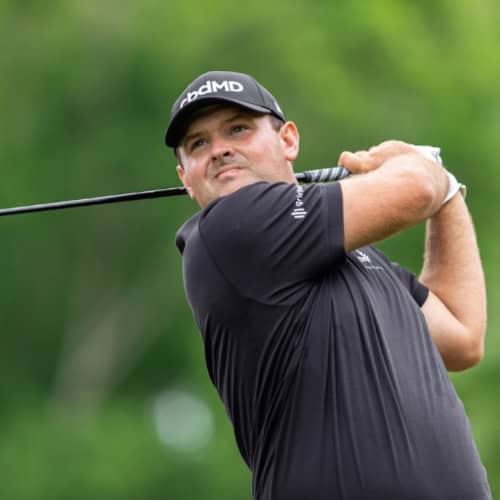
Former Ryder Cup partners Patrick Reed and Jordan Spieth experienced a fallout that grabbed headlines and sparked discussions about team dynamics.
After a successful partnership in the 2016 Ryder Cup, Reed criticized Spieth for not wanting to pair with him in 2018. Reed’s comments were candid, suggesting deeper issues within the team.
The tension between the two highlighted the importance of chemistry in team events. Their fallout reminded us that personal relationships can significantly impact performance.
Vijay Singh vs. Phil Mickelson: 2005 Masters Confrontation

The 2005 Masters brought a heated clash between Vijay Singh and Phil Mickelson, showcasing that even the best can lose their cool.
The altercation began when Singh accused Mickelson of leaving spike marks on the greens. The disagreement led to a near-physical confrontation, surprising fans accustomed to golf’s polite demeanor. Although the incident was eventually resolved, it left a mark on their relationship.
Historical Perspectives: Sam Snead vs. Ben Hogan
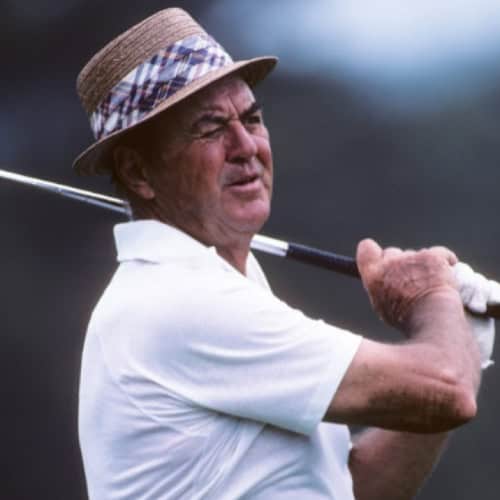
The rivalry between Sam Snead and Ben Hogan, spanning over two decades from the late 1930s, is one of the most compelling in golf history. Their contrasting styles and personalities, coupled with their remarkable skill, defined an era and left an indelible mark on the sport.
Snead, known for his fluid swing and natural athleticism, amassed 82 PGA Tour wins and seven major championships. Hogan, celebrated for his precision and relentless work ethic, earned the nickname “The Hawk” and claimed 64 PGA Tour wins and nine majors, despite a near-fatal car accident in 1949.
Their rivalry was punctuated by iconic moments:
- 1942 Hale America National Open: Hogan’s playoff victory over Snead.
- 1950 U.S. Open at Merion: Hogan’s triumphant return and playoff win.
- 1954 Masters Tournament: Snead’s playoff victory over Hogan.
Beyond filling record books, Snead and Hogan’s rivalry catalyzed golf’s popularity. Media narratives of their contrasting styles and competitive spirit drew new fans, while their thrilling matches attracted large crowds and captivated radio audiences. Their legacy set a standard for future generations, demonstrating golf’s potential for drama and competition.
The Snead-Hogan rivalry transcends golf history; it’s a testament to how the fierce competition between two greats elevated the sport and inspired generations of golfers and fans.
Controversies and Conflicts: Impact on the Game
Golf, despite its serene exterior, has seen its fair share of controversies and conflicts. These moments have not only shaped individual careers but also impacted the sport’s broader narrative.
Tom Watson vs. Gary Player: Accusations of Cheating
The 1983 Skins Game witnessed an unexpected twist when Tom Watson accused Gary Player of cheating by moving a clump of grass before a chip shot. This accusation shocked the golf community.
During the televised event, Watson claimed Player had broken the rules. The accusation, made in the heat of competition, drew widespread attention. Some sided with Watson, emphasizing the importance of rules, while others defended Player, citing the intense pressure of competition.
Although Watson later expressed regret for the public nature of his accusation, the incident highlighted the sport’s strict adherence to rules and the integrity expected of its players.
Sergio Garcia vs. Nick Faldo: Ryder Cup Criticism and Its Aftermath
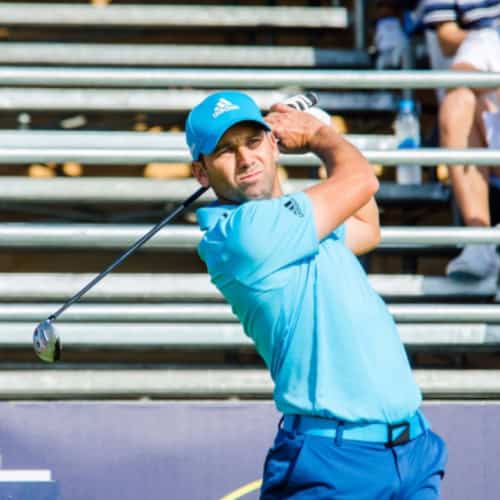
Sergio Garcia and Nick Faldo’s tension came to a head during the 2008 Ryder Cup. Faldo’s comments about Garcia’s lackluster play struck a nerve. Garcia fired back, questioning Faldo’s leadership and decisions as captain. The exchange between two high-profile golfers created a stir, with fans and media dissecting every word.
This incident left a lingering strain on their relationship. Garcia’s later jabs at Faldo, especially upon becoming Europe’s all-time points leader, underscored the depth of their animosity.
Tiger Woods vs. Sergio Garcia: Long-Running Animosity
The rivalry between Tiger Woods and Sergio Garcia has been marked by a series of clashes and controversial remarks, making headlines over the years.
Their rivalry began with competitive tension on the course, but it soon spilled over into personal animosity. The feud escalated dramatically when Garcia made an offensive remark about Woods during a European Tour dinner. The comment, widely condemned as racist, intensified their rivalry.
Despite occasional attempts to downplay their differences, the animosity between Woods and Garcia has remained a persistent undercurrent in their interactions.
Frequently Asked Questions
The following are some frequently asked questions related to golf’s greatest rivalries and feuds that helped shape the game of golf that we know and love today.
What was the greatest rivalry in golf history?
The rivalry between Arnold Palmer and Jack Nicklaus is often considered the greatest in golf history. Their battles throughout the 1960s and 1970s defined an era, with Nicklaus’ precision and power contrasting Palmer’s charisma and daring play. Together, they elevated the sport’s popularity, attracting a new generation of fans.
How did the rivalry between Arnold Palmer and Jack Nicklaus shape modern golf?
Palmer and Nicklaus brought a new level of excitement and attention to golf. Palmer’s fan-friendly approach and aggressive playstyle, combined with Nicklaus’ methodical and dominating presence, created a dynamic that captured the public’s imagination.
Their rivalry spurred media interest, increased tournament viewership and ultimately contributed to golf’s growth into a major global sport.
What are some of the most memorable moments from the Ryder Cup?
The Ryder Cup has produced numerous unforgettable moments:
– 1985 – Europe won for the first time in 28 years, breaking the U.S. dominance.
– 1991 – The “War on the Shore” at Kiawah Island featured intense matches and a narrow U.S. victory.
– 1999 – The U.S. comeback at Brookline, where Justin Leonard’s long putt secured a dramatic win.
– 2012 – The “Miracle at Medinah,” where Europe overcame a significant deficit on the final day to win.
How have personal feuds affected players’ performances in major tournaments?
Personal feuds can significantly impact players’ performances. For example, the fallout between Patrick Reed and Jordan Spieth in the Ryder Cup led to a breakdown in team chemistry, affecting their overall performance.
Similarly, the tension between Brooks Koepka and Bryson DeChambeau created distractions that some argue affected their focus and play.
These personal conflicts add a layer of psychological complexity to tournaments, influencing outcomes in unpredictable ways.
Who are the top female golfers with historic rivalries?
Here are some memorable female golfer rivalries:
– Mickey Wright vs. Kathy Whitworth – The golfers dominated the LPGA in the 1960s and 1970s, with their head-to-head battles defining the era.
– Annika Sörenstam vs. Karrie Webb – Their rivalry in the late 1990s and early 2000s pushed both to achieve incredible results, leading to numerous memorable duels.
– Nancy Lopez vs. Beth Daniel – In the 1980s, these two stars frequently competed for titles, showcasing the depth of talent in women’s golf.
These rivalries brought increased attention and respect to women’s golf, contributing to the sport’s growth and popularity.
Final thoughts
Golf rivalries have fueled some of the sport’s most thrilling moments. The fierce competitions between legends like Arnold Palmer, Jack Nicklaus and Gary Player have defined eras, drawing fans into the sport’s rich history. These battles, rooted in respect or animosity, push players to greatness, creating lasting memories on the green.
As golf evolves, new rivalries will emerge, continuing to captivate fans and push the sport to new heights. The next great rivalry is always just around the corner.
Thanks for reading!





